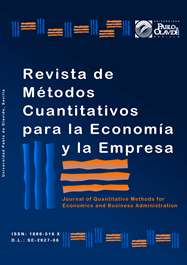Modeling of Insolvency Risk in Health Sector Companies Using Logit Models
DOI:
https://doi.org/10.46661/revmetodoscuanteconempresa.2757Keywords:
insolvencia, modelos logit, indicadores financieros, insolvency, logit models, financial indicatorsAbstract
This article shows the prediction of the level of insolvency in companies that are not listed on the stock exchange belonging to the health sector for one and two years in advance, using the multiple logistic regression analysis based on indicators of liquidity, indebtedness, financial structure and profitability. The period 2010-2013 is taken as a reference for a sample of 3,930 companies categorized by size (large, medium, small and micro) and classified by their level of high, medium and low insolvency risk. The success results of the models are between 70% and 80% for each of the years, validating the results obtained throughout the study.
Downloads
References
Alaka, H.; Oyedele, L.; Owolabi, H.; Kumar, V.; Ajayi, S.; Akinade, O. & Bilal, M. (2018). Systematic Review of Bankruptcy Prediction Models: Towards a Framework for Tool Selection. Expert Systems with Applications, 94, 164-184.
Altman, E. (1968). Financial Ratios, Discriminant Analysis and the Prediction of Corporate Bankruptcy. The Journal of Finance, 23(4), 589-609.
Altman, E. (1981). Financial Handbook. New York: John Wiley & Sons.
Appiah, K.; Chizema, A. & Arthur, J. (2015). Predicting corporate failure: A systematic literature review of methodological issues. International Journal of Law and Management, 57(5), 461-485.
Aziz, M. & Dar, H. (2006). Predicting corporate bankruptcy: Where we stand? Corporate Governance: The International Journal of Business in Society, 6(1), 18-33.
Beaver, W.H. (1966). Financial Ratios as Predictors of Failure. Journal of Accounting Research, 4(3), 71-111.
Collins, R. & Green, R. (1982). Statistical methods for bankruptcy forecasting. Journal of Economics and Business, 34(4), 349-354.
De Llano, P.; Piñeiro, C. & Rodriguez, M. (2016). Business failure prediction. A contribution to the synthesis of a theory, through comparative analysis of different prediction techniques. Estudios de Economía, 43(2), 163-198.
Fitzpatrick, F. (1932). A Comparison of Ratios of Successful Industrial Enterprises with Those of Failed Firm. Certified Public Accountant, 6, 727-731.
Korol, T. (2013). Early warning models against bankruptcy risk for Central European and Latin American enterprises. Economic Modelling, 31, 22-30.
Laffarga, J.; Martín, J. & Vázquez, M. (1985). El análisis de la solvencia de las instituciones bancarias: Propuesta de una metodología y aplicaciones a la Banca española. ESIC-Market, 48, 51-73.
Lennox, C. (1999). Identifying failing companies: A re-evaluation of the logit, probit and DA approaches. Journal of Economics and Business, 51(4), 347-364.
Lincoln, M. (1984). An empirical study of the usefulness of accounting ratios to describe levels of insolvency risk. Journal of Banking & Finance, 8(2), 321-340.
McDonald, B. & Morris, M. (1984). The statistical validity of the ratio method in financial analysis: an empirical examination. Journal of Business Finance & Accounting, 11(1), 89-97.
Mures, M.; García, A. & Vallejo, M. (2012). Análisis del fracaso empresarial por sectores: factores diferenciadores. Pecunia, Monográfico 2010, 53-83.
Ohlson, J. (1980). Financial Ratios and the Probabilistic Prediction of Bankruptcy. Journal of Accounting Research, 18(1), 109-131.
Pereira, J.; Crespo, M. & Sáez, J. (2007). Modelos de Previsão do Fracasso Empresarial: Aspectos a considerar. Revista de Estudos Politécnicos, 4(7), 111-148 (en portugués).
Pérez, C. & Santín, D. (2007). Minería de datos. Técnicas y herramientas. Madrid: Paraninfo.
Platt, H. & Platt, M. (2002). Predicting corporate financial distress: Reflections on choice-based sample bias. Journal of Economics and Finance, 26(2), 184-199.
Premachandra, I.; Bhabra, G. & Sueyoshi, T. (2009). DEA as a tool for bankruptcy assessment: A comparative study with logistic regression technique. European Journal of Operational Research, 193(2), 412-424.
Ravi, P. & Ravi, V. (2007). Bankruptcy prediction in banks and firms via statistical and intelligent techniques – A review. European Journal of Operational Research, 180(1), 1-28.
Rodríguez, C.; Maté, M. & López, F. (2017). El contagio en el fracaso empresarial como consecuencia de la proximidad geográfica: un análisis con los estadísticos join-count aplicado al sector servicios. Revista de Métodos Cuantitativos para la Economía y la Empresa, 23, 75-95.
Sun, J.; Li, H.; Huang, Q. & He, K. (2014). Predicting financial distress and corporate failure: A review from the state-of-the-art definitions, modeling, sampling, and featuring approaches. Knowledge-Based Systems, 57, 41-56.
Tam, K. & Kiang, M. (1990). Predicting bank failures: A neural network approach. Applied Artificial Intelligence, 4(4), 265-282.
Tascón, M. & Castaño, F. (2012). Variables y modelos para la identificación y predicción del fracaso empresarial: revisión de la investigación empírica reciente. Revista de Contabilidad, 15(1), 7-58.
Turetsky, H. & McEwen, R. (2001). An empirical investigation of firm longevity: A model of the ex ante predictors of financial distress. Review of Quantitative Finance and Accounting, 16(4), 323-343.
Zmijewski, M. (1984). Methodological Issues Related to the Estimation of Financial Distress Prediction Models. Journal of Accounting Research, 22, 59-82.
Downloads
Published
How to Cite
Issue
Section
License
Copyright (c) 2018 Journal of Quantitative Methods for Economics and Business Administration

This work is licensed under a Creative Commons Attribution-ShareAlike 4.0 International License.
Submission of manuscripts implies that the work described has not been published before (except in the form of an abstract or as part of thesis), that it is not under consideration for publication elsewhere and that, in case of acceptance, the authors agree to automatic transfer of the copyright to the Journal for its publication and dissemination. Authors retain the authors' right to use and share the article according to a personal or instutional use or scholarly sharing purposes; in addition, they retain patent, trademark and other intellectual property rights (including research data).
All the articles are published in the Journal under the Creative Commons license CC-BY-SA (Attribution-ShareAlike). It is allowed a commercial use of the work (always including the author attribution) and other derivative works, which must be released under the same license as the original work.
Up to Volume 21, this Journal has been licensing the articles under the Creative Commons license CC-BY-SA 3.0 ES. Starting from Volume 22, the Creative Commons license CC-BY-SA 4.0 is used.










